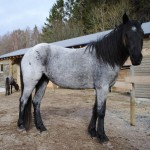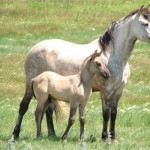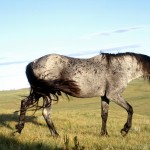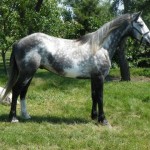Nokota Horse
One of the rare breeds of semi-feral horses found in the Little Missouri Badlands in southwest North Dakota, the versatile and intelligent Nokota horse has been used in various events of racing and riding. It is believed that the breed is named after the local Nakota tribe that inhabited the Dakota region while others think that its name is a combination of the two words – North and Dakota. The breed was saved from extinction during the 1940s when some herds of Nokota horses were trapped and preserved in Theodore Roosevelt National Park.
Nokota Horse Pictures
- Black Nokota Horse
- Nokota Horse Blue Roan
- Nokota Horse Foal
- Nokota Horse Images
- Nokota Horse Jumping
- Nokota Horse Pictures
- Nokota Horse Stallion
- Nokota Horse
- Nokota Horses Pictures
- Nokota Horses
Quick Information
| Temperament / Personality | Playful, observant, sociable, intelligent, obedient, cooperative, and kind; honest in its actions and communications |
| Physical Characteristics | Square and angular conformation with prominent withers; sloped croup with a low-set tail, strong legs and hooves; most Nokota horses have feathers on their fetlocks; slightly hooked ears |
| General Types | · Traditional Nokota or the National Park Traditional: Resemble the Colonial Spanish Horse; more refined and smaller than the second type
· Ranch-type or the National Park Ranch: Resemble early Quarter Horses |
| Colors | Blue roan, gray, and black are predominant while chestnut, dun, palomino, bay, red roan, and grullo are the less common colors; overo and sabino patterns are also seen occasionally |
| Blood Type | Warmblood |
| Common Use | Endurance and western riding, dressage, show jumping, three-day eventing, fox hunting, ranch work, and studying horsemanship |
| Lifespan/Life Expectancy | Generally long-lived |
| Height (size) | The Traditional Nokota is 14-14.3 hands high (142-150 cm, 56-59 inches); the Ranch-type Nokota is 14.2-17 hands high (147-173 cm, 58-68 inches) |
| Weight | The average weight is 408 kg (900 lbs) |
| Health | A healthy breed with no known health concerns |
| Gaits/Movements | The Nokota horses have a four-beat intermediate movement that was previously called the “Indian shuffle” |
| Popular Traits | Athletic build, soundness, agility, hardiness, great stamina, ambling gait, versatility |
| Feeding/Diet | Good-quality hay is sufficient; you can add small amounts of grain; roughage is equally important since it provides the bulk of the calories; always adjust the amount of food a horse needs depending on its size and the activity level |
| Country of Origin | The United States |
| Ancestors | Local Native American horses, Thoroughbreds, Spanish horses, Harness horses |
| Year/Time of Development | In the 19th century |
| Breed Information | Recognized and registered by the Nokota Horse Registry |
Nokota Horse Video
History and Development
Back in the nineteenth century, American ranchers found herds of local feral horses in the North Dakota region. This population included a mix of original feral and domestic horses. The Nokota horse originated when local Indian ponies were crossed with Thoroughbreds, Spanish, as well as various draft and harness horses. In the early twentieth century, many feral horses were rounded up by the local ranchers and were either used for ranch work or slaughtered in order to restrict grazing competition among domestic livestock. This caused a major decline in the number of wild horses.
During the construction of Theodore Roosevelt National Park in the 1940s, few herds of feral horses were unintentionally left within the fence. This preserved the population of wild horses in North Dakota. Nevertheless, the authorities were determined to remove these “undesirable exotics” and the exemption of National Park Service from the Wild and Free-Roaming Horses and Burros Act allowed them to send many of these animals to slaughter. However, protests by the local people against the removal efforts grew and by 1970, the removal policy was re-evaluated. Now, the herds of feral horses in the National Park are controlled for historical demonstration.
In 1986, outside bloodlines were introduced by the park officials with the intention of improving the appearance of Nokota horses. They replaced the dominant stallions with an Arabian, a Quarter Horse, and a part-Shire stallion. Moreover, many wild horses were sold at an auction. Concerned about their future, Frank and Leo Kuntz bought 54 horses at the auction held in 1986. The Kuntz brothers purchased some horses at subsequent auctions, and by 1993, they had rounded up a band of 150 horses that were mainly used for ranching as well as endurance races. The Kuntz brothers established the Nokota Horse Conservancy in 1999 with an objective to conserve and promote the breed. The organization has a breed registry known as the Nokota Horse Registry.
Interesting Facts
- The blue roan coat coloration is very rare in equine breeds, and so it is a distinguishing feature of the Nokota horse.
- The Nokota horse breed has been conferred the title of Honorary State Equine of North Dakota.













